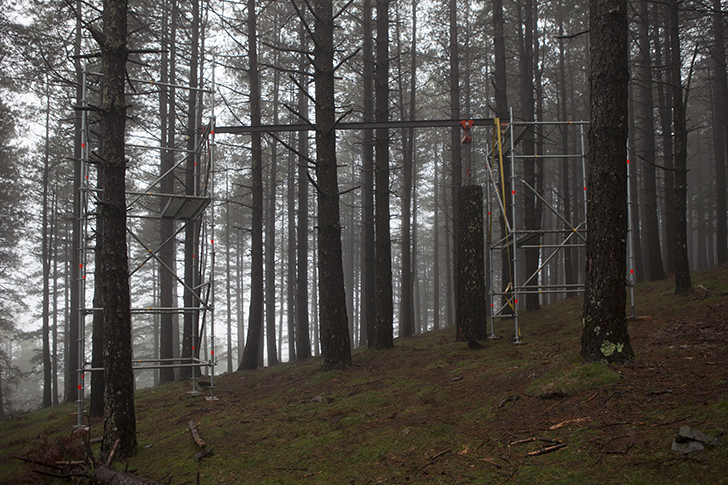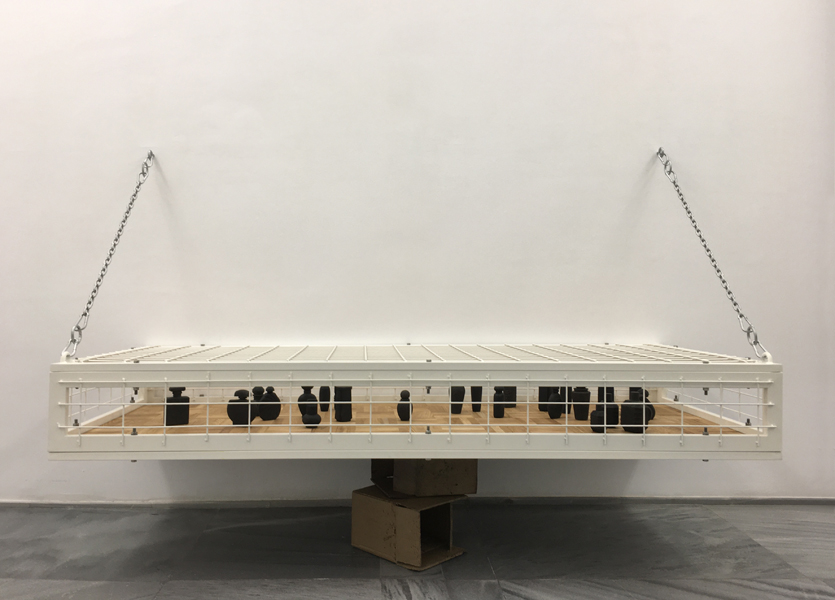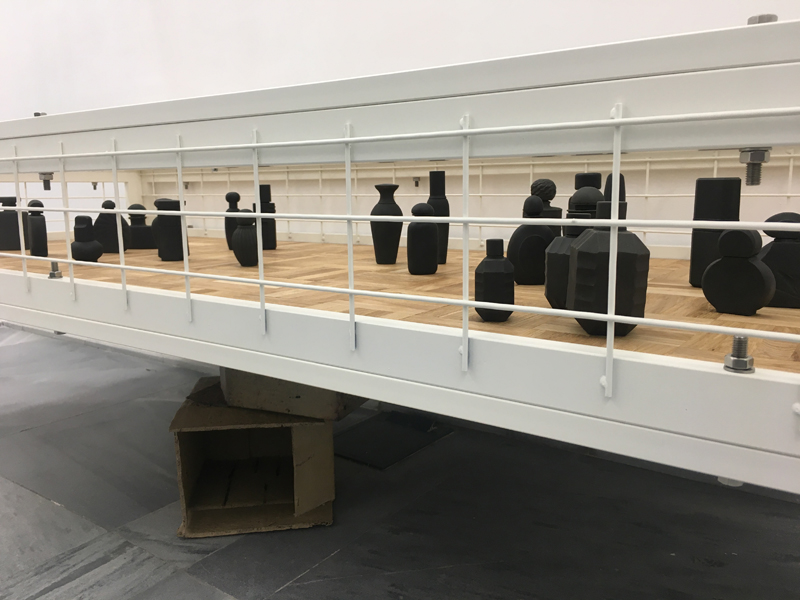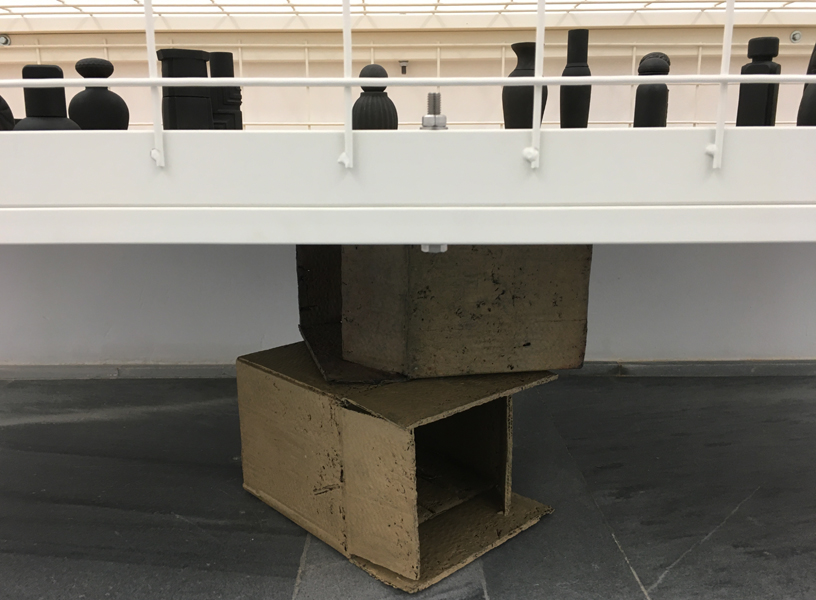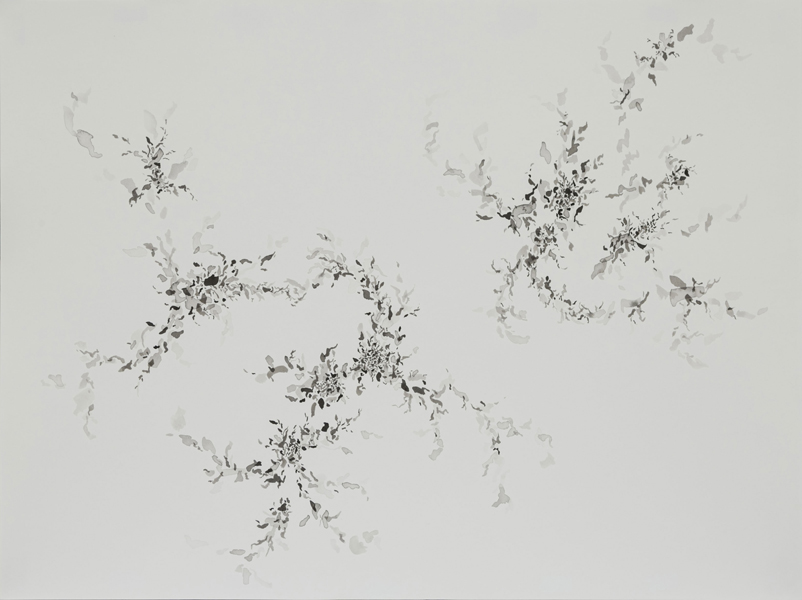ECOCÉNTRICAS .- Bene Bergado / Donna Conlon / Maider López
30/Nov/2020 - 30/Jan/2021

For two decades, we are attending the rise of social, economic, political and identity conflicts, issues involving dichotomous relationships established between nature and culture. These issues have been discussed both politically and epistemologically from different disciplinary fields of knowledge and processes. In this sense, artistic practice has shown a particularly active role. (…) from the sixties, certain artistic practices coincide contain the concept of ecology as a constant feature, in order that models of “development” alternative to the modern paradigm, based on different value systems and knowledge, begin to gain more strength socially.
Belén Romero Caballero. Ecological art practices a state of the art.
ECOCÉNTRICAS, the new project of the Espacio Minimo gallery, presents recent works by three artists, Bene Bergado, Donna Conlon and Maider López who, each from a personal perspective, have included Ecology as one of the central axes of their artistic practice.
SQM is the title of Bene Bergado‘s work, a cage-bed suspended from the wall like the old cots in prisons, with an internal park floor resembling a place, a room. The bed as a place of rest, of dreams, of desire, but also of illness, and of nightmare that contains in its interior bronze reproductions of containers of prohibited products for those who have the syndrome of multiple chemical sensitivity (MCS, in spanish SQM) in this case women, who have provided the artist with packaging and information for its reproduction in bronze. About this project the artist writes:
My interest in life and environment’s transformations generated by the production systems of materials and products for daily consumption and domestic use has been present in my pieces since the 90s. This is the first project in which I collect the fieldwork that I have been working on the subjective and cultural implications that arise in the face of environmental disease recognized as “multiple chemical sensitivity”, and the people affected by it, mostly women, as sensors of a sick environment whose body alarms an irreversible situation of global toxicity, consequence of the success of the so-called “welfare society”, and cause of its decomposition.
The video From the Ashes (Desde las cenizas) and the installation of drawings Sunspots (Manchas solares) are the two works that Donna Conlon shows in this exhibition. About Sunspots she writes:
The day before the quarantine started in Panama, I saw a point of light that danced and mutated on a tree trunk in the forest. Mesmerized, I decided to call it sunspot. Although I know this term actually refers to dark spots on the surface of the sun. The next day, inside my house, I started looking for images on the internet of sun spots – inked spills with radiation swirling outwards. They are dark, cold and magnetic and their activity has to do with temperatures on Earth, but not much else is known about them. It is impossible to get close to the surface of the sun so the images are always blurry, vague, out of focus. I got caught up in those mysterious and dramatic images – just when my access to the sun was blocked – and I started to draw them. In doing so, trying to give shape and definition to the imperceptible, I saw darkness as disease and radiation as contagion or connectivity. Their shapes also echo that of our entire galaxy, evoke an unlimited capacity to make connections, and suggest the infinite possible types of growth of organic beings. Are they symbols of doom or opportunity? This metaphor – contradictory and uncertain – is both terrifying and comforting to me, as well as drawing it.
Generally, it is in my immediate surroundings where I look for metaphors -of human behavior and the interactions we have with our natural, physical and cultural world- to make videos, drawings, or other works in an experiential process based on things that I can touch and see clearly. But as the walls have closed, I have looked at the physical world that exists beyond my reach, at temperatures impossible to touch. During these times of contemplation, isolation, and longing, it has become vital for me to enter into a more thoughtful exploration of the unknown and indiscernible of the world we inhabit.
Conlon’s background in science greatly informs her work across a variety of art mediums. She scours her environment for useless, worthless items, which she then uses to paint a subtle portrait of a consumer culture whose ecological impacts are hidden in plain sight, should we only observe the world more astutely. Conlon aspires to stimulate an awakening, a collective enlightenment, as to our species’ precarious status. Her practice unites biology and art, archaeology and anthropology.
The video From the Ashes (Desde las cenizas) opens with an abstract image, which is revealed to be a small bird, seemingly dead or dying, held in a hand. The tiny hummingbird suddenly comes to life and elevates into a liberated flight, like the Phoenix of Greek mythology, which was reborn from its own ashes, or the hummingbirds of Aztec societies, which were believed to be resurrected warriors. As we collectively confront a mortal environmental crisis, this video questions our relationships with the natural world and presents an image of the essence of nature: strong, tenacious and perseverant, despite of humankind.
BASOA, the work of Maider López that we show consists of a video and a series of photographs that document the recording process from another point of view, to discover what is hidden in the video. The artist says:
Fixed shot of a forest, trees at different depths shows a bucolic nature in which nothing happens, only the trees, the rain and the fog. At one point, there seems to be a movement that is not easy to recognize. One of the trees is moving slowly, almost imperceptibly. A tree is moving until it leaves the plane. From another point of view, we would see a person walking and carrying a log.
Basoa means Forest in Basque (euskera). The project calls into question the limits of landscape and reality; at the same time that it makes visible the constant transformation of nature; nature is in constant motion at a very slow pace, imperceptible to the human eye.
BENE BERGADO (Salamanca 1963). Graduated in Fine Arts from the University of the Basque Country. In 1987 she obtained the Grant for Artistic Creation from the Vizcaya Provincial Council and was a Professor at the Faculty of Fine Arts of the Basque Country from 1987 to 1997. She currently lives and works in Madrid. She has exhibited individually in galleries and institutional rooms such as the Sala Carlos III of the Public University of Navarra in Pamplona, the Abrantes Palace in Salamanca or BILBAO Arte in Bilbao, and has participated in important group exhibitions such as Muesatra de Arte Joven (1992) at the Spanish Museum of Contemporary Art in Madrid, Distancia Cero (1994) at the Santa Mónica Art Center in Barcelona, Gure Artea (1996) at the Sala Rekalde in Bilbao, Procesos (1997) International Festival of Lima, Peru, How we see ouselves. Images and female archetypes (1998) Centro Cultural Sala Tecla, Hospitalet (Barcelona), Trans Sexual Express (1999) BILBAO Arte, Bilbao, PASION. Spanish design (2002), traveling exhibition in Germany and Spain, Images of women in 20th century Spanish plastic arts (2003) Pablo Serrano Museum, Zaragoza, Indisciplinados (2003) MARCO. Contemporary Art Museum of Vigo, Go to your room (2003) Casa Encendida, Madrid, Contemporary Art. Castilla y León (2005) White Box, New York, Drawing upside down (2006) Centro Cultural Montehermoso of Vitoria, For all audiences (2006) Sala Rekalde, Bilbao, Inventories (2007) MUSAC. Museum of Contemporary Art of Castilla y León, León, INCÓGNITAS. Cartographies of contemporary art in the Basque Country (2007) Guggenheim Museum, Bilbao, Supraficciones (2007) Caixa Foundation, Lleida, Sculpture (2008) Sala de la Comunidad de Madrid, Alcala 31, Madrid, Poole! (2012) Fundación JUMEX, México D.F, Persona (2016-18) Centro Párraga, Murcia and MUSAC León, among others. Her work is represented in important Spanish collections such as the MUSAC (Museum of Contemporary Art of Castilla y León) in León, the ARTIUM Museum in Vitoria, the Banco España Collection in Madrid, the Provincial Council of Vizcaya Bilbao … or abroad such as the JUMEX Collection from Mexico DF, Tiqui Atencio, London or Estrellita B. Brodsky Collection from New York
DONNA CONLON (Atlanta, 1966). Lives and works in Panama City. She has participated in the 51st Venice Biennale in 2005, in the Arsenale exhibition as well as in the Italo-Latin American Institute exhibition. She has also shown her work in The Met Breuer (2019); Fridman Gallery (2019); The La Moneda Cultural Center, Santiago, Chile (2018); Diablo Rosso, Panama (2018); the Asunción Biennial, Paraguay (2015); Prefix Institute of Contemporary Art, Toronto, Canada (2013); the Museum of the City, Cuernavaca, Mexico (2013); Museum of Latin American Art, Long Beach, California (2011); El Museo del Barrio, New York, NY (2011); Rufino Tamayo Museum, Mexico City (2008); Festival of Contemporary Art in Prague, Prague, Czech Republic (2008); Oi Futuro, Rio de Janeiro, Brazil (2007); the 3rd Auckland Triennial, Auckland Art Gallery, Auckland, New Zealand, (2007); Centraal Museum, Utrect, The Netherlands (2006); and Istanbul Museum of Modern Art (2006). In 2007 she received a scholarship for emerging Latin American artists from the Cisneros Fontanals Art Foundation (CIFO). Her work is in recognized collections such as the Ella Fontanals-Cisneros Art Foundation (Miami), Daros Latinamerica (Zurich) and the Metropolitan Museum of Art (New York). Since 2006 she has made many videos in collaboration with Jonathan Harker. They have exhibited their collaborations extensively, in solo exhibitions at the Eli and Edythe Broad Art Museum, Michigan State Univ, East Lansing, Michigan (2018); Kadist, San Francisco (2018); Biomuseo, Panama (2018); NuMu at Los Angeles County Museum of Art (2018); The Spanish Cultural Center, Panama (2017); Diablo Rosso Gallery, Panama (2015); Washington Project for the Arts (2015); Des Pacio, San José, Costa Rica (2014); Minimum Space Gallery, Madrid (2014); Fridman Gallery, New York, NY (2014); Neuberger Museum of Art, Purchase College, Purchase, New York (2014); The New Museum of Contemporary Art (NuMu), Guatemala (2014); TEOR / éTica, San José, Costa Rica (2009); Samson Projects, Boston (2007); as well as group exhibitions at the Solomon R. Guggenheim Museum, New York (2014); Pérez Art Museum, Miami (2014); The Museum of Contemporary Art and Design, San José, Costa Rica (2014); Galician Center for Contemporary Art, Santiago de Compostela, Spain (2013); Queensland Art Gallery, Brisbane, Australia (2012); El Museo del Barrio, New York (2012); and Palais du Tokyo, Paris (2009). They have also participated in events and biennials such as Pacific Standard Time: LA / LA, Los Angeles (2017); Prospect New Orleans (2017); the Biennial of the Americas, Denver (2015); the 43 (Inter) National Artists Salon, Medellín, Colombia (2013); the VIII Biennial of Mercosur, Porto Alegre, Brazil, (2011); Biennial of Pontevedra, Spain (2010) and X Biennial of Havana (2009). His contributions are included in various public collections, including the Solomon R. Guggenheim Museum; the Tate Modern in London; Queensland Art Gallery – Gallery of Modern Art, Brisbane; the Kadist Art Foundation, Paris / San Francisco; and the Galician Center for Contemporary Art, Santiago de Compostela. Her work is represented by Diablo Rosso in Panama.
MAIDER LÓPEZ (San Sebastián, 1975). She develops her work intervening in public space and architecture. Her works often require the participation of the viewer she involves, making them part of a subtly altered space. Her work has been widely exhibited nationally and internationally. She has participated in the 2005 Venice Biennials (The Experience of Art, 51 Venice Biennale), Sharjah 2009 (Provisions for the Future, Sharjah Biennial 9, United Arab Emirates) and Istanbul 2013 (Mom, am I Barbarian 13th Istanbul Biennial ). She has also carried out projects in public space and exhibited in Museums and galleries such as: Zoom In, Galería Espacio Minimo (2017); Matadero Madrid (1645 Chalks, 2016); Koldo Mitxelena from San Sebastián and MARCO from Vigo (Displacement 2015 and 2016); Les Ateliers de Rennes, 4th Biennale d’Art Contemporain, Rennes, France (Play Time, 2014); Lower Austria Contemporany (Mountain, 2013); Skor and Witte de With, The Netherlands (Polder Cup, 2010); Center Pompidou-Metz (Eclats, 2010); SCAPE Christchurch Biennial of Art in Public Space, New Zealand (2008); Chacun à Son Goût. Guggenheim Bilbao (2007); o Caixa Forum, Barcelona (Columnes, 2006), Prospect, New Orleans USA 2017, among others.
Watch the videos on Vimeo:









